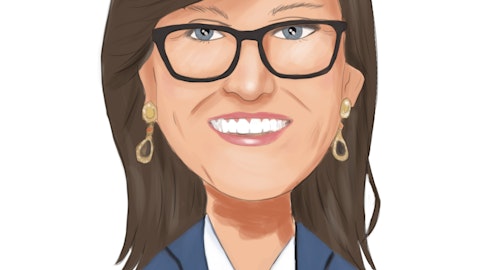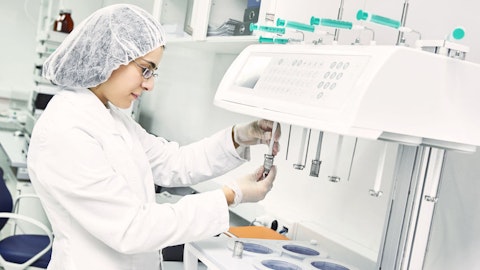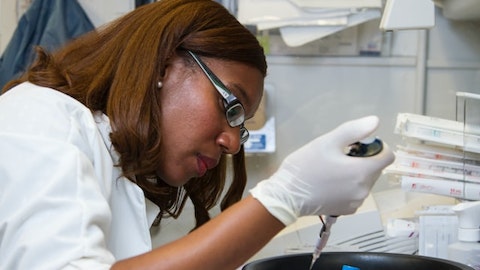Leland Gershell: Okay. Thanks. I think I got most of that a little broken up on the connection, but thank you for taking the question.
Operator: Our next question will come from the line of Paul Choi with Goldman Sachs.
Paul Choi: Hi, thanks and good morning. Thank you for taking our questions. My first question is for Mark. I think there seems to be some persistent confusion in the market just with regard to follow-up period for ENVISION here. And could you maybe just again clarify for us what the total follow-up period will be? It’s three months for the installation period followed by 12 months, if my understanding is correct, if you could just confirm that for us?
Mark Schoenberg: Paul, thank you. I hope you can hear me. You are absolutely correct. So when we say 12 months of follow-up, we mean 12 months after the initial evaluation [technical difficulty] in trial. So it would be 15 months from the beginning of the study, but 12 months from the primary disease evaluation. So you are correct. It’s 12 months after that initial three months [technical difficulty] evaluation. So 15 months into the trial 12 months following CR.
Paul Choi: Great. Perfect. Thanks for clarifying the 15 months of total time. And then my second question is just for both maybe Liz and Don, just with respect to the guidance and cash burn. If we take the midpoint of your revenue guidance and the midpoint of your OpEx guidance and we strip out the noncash items, including stock comp as well as the RTW financing expense, we get to a range of roughly $40 million to $45 million in incremental cash burn versus 2023. And I was just wondering if you could clarify how much of that related to the build out of your sales force that Jeff referenced earlier versus incremental R&D spend for UGN-103 and 104 and just the timing of when that cash burn would potentially accelerate. Are we correct to assume that it will be primarily back-end weighted towards the end of 2024? Thanks so much.
Elizabeth Barrett: So I’ll let Don give you details. But yes, towards the — you are right, it will be more in the back end. But Don, do you want to give more color around that?
Dong Kim: Absolutely, Liz. Thank you, Paul. So basically, this $40 million increase in OpEx, you are correct. And big portion, like 25%, 30% of the $40 million increase is actually one or two commercial, the product buildup because before we get the FDA approval, we cannot use this as a cost. So we just use it as expense for inventory buildup and the other — another portion of 50% of this incremental OpEx is obviously the sales force buildup and brand marketing. So as you just mentioned that, yes, it’s more at the back end of the year, but it will be incremental cost.
Elizabeth Barrett: And there’s just minor incremental in R&D because of the — with the 103 and 104 trial starting this year.
Paul Choi: Okay, great. That’s a, that’s a lot of helpful detail. Thanks so much for clarifying.
Elizabeth Barrett: Thanks Paul.
Operator: Our next question will come from the line of Matt Kaplan with Ladenburg Thalmann.
Matt Kaplan: Hi, good morning guys. Thanks for taking the questions. I guess just staying on 102 initially. What’s your expected chance for the FDA toward a priority review to the — once the final is complete in September?
Elizabeth Barrett: Look, you never know, Matt, so we can’t guarantee it, but I think there’s a lot of things that’s going in our favor. One, we had a priority review for JELMYTO; two, assuming the data is consistent when we see the duration data the data right now is very compelling. And I think that the FDA understands the unmet need out there and the need to get these treatments out there. So — and we believe we have a high probability of a priority review, and that’s our expectation. So again, you can’t say for sure because we won’t know until we file and ask for priority review, but we did get the rolling submission that we asked for. We have started that, as you know. And so I think that we feel like we’re in a good position to do that.
Matt Kaplan: Sure. Makes sense. And then in terms of after approval, what’s your expected ramp of payer coverage for 102? And how should we think about that?
Elizabeth Barrett: Yes. Silvio, since you joined us today, why don’t you talk about the payer from a 102 perspective?
Silvio Pacheco: Sure. Matt, thanks for the question. So from a payer coverage perspective, I think there’s a couple of elements to consider. One is the inclusion of 102 in the treatment guidelines with the National Comprehensive Cancer Network. And also the application of the J-code. So the application for a J-Code happens on a quarterly basis, and it is dependent on the FDA approval. So we will work expeditiously to get the J-Code up and running. And we will start engaging payers in the next few months here. providing them with some preapproval information so they can become aware of UGN-102 and the clinical value proposition of UGN-102.
Elizabeth Barrett: But Silvio, can you just comment — I mean, our expectation, we have over 99% coverage on JELMYTO. We don’t expect it to be different for UGN-102. We expect significant coverage out of the gate. As you know, about 70% of the population is Medicare. And that gets covered because if you get an FDA approval, then Medicare covers it. So we don’t really have an issue there. And even with commercial initially, we’ll — we won’t have a problem and we don’t — we expect it to be pretty close to where we are with JELMYTO, which what I say over 99% coverage.
Matt Kaplan: Okay. Great. Great. And then just with UGN-103 and 104 you stated that you plan to start Phase III development for both, but that it would be smaller and more focused studies. Can you give us a little bit more detail in terms of what the regulatory path looks like for both of those? Is it just one study needed for each of them? Or how will it work, do you think?





